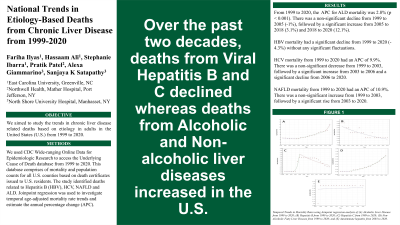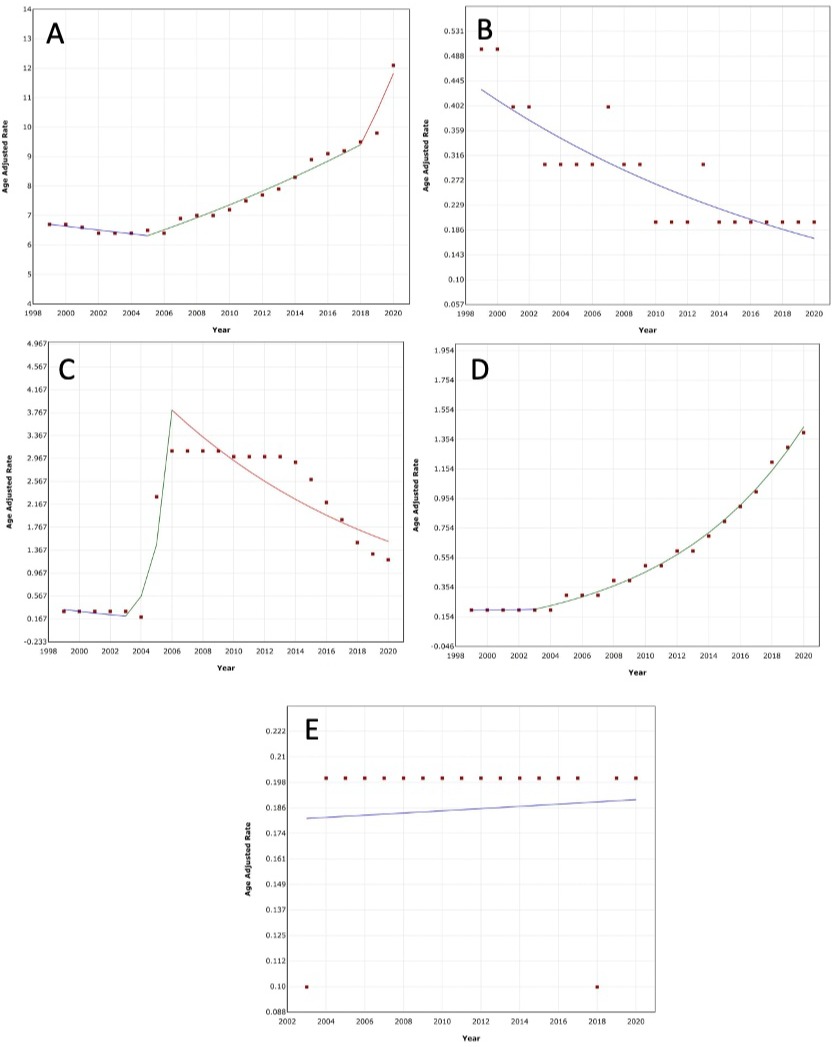Sunday Poster Session
Category: Liver
P0963 - National Trends in Etiology-Based Deaths from Chronic Liver Disease From 1999-2020
Sunday, October 22, 2023
3:30 PM - 7:00 PM PT
Location: Exhibit Hall


Fariha Ilyas, MD
ECU Health Medical Center / Brody School of Medicine
Greenville, NC
Presenting Author(s)
Fariha Ilyas, MD1, Hassam Ali, MD1, Stephanie Ibarra, MD1, Pratik Patel, MD2, Alexa Giammarino, MD3, Sanjaya Satapathy, MD3
1ECU Health Medical Center / Brody School of Medicine, Greenville, NC; 2Mather Hospital/Hofstra University Zucker School of Medicine, Port Jefferson, NY; 3North Shore University Hospital/Zucker School of Medicine at Hofstra University, Manhasset, NY
Introduction: New hepatitis C (HCV) treatments have steadily reduced mortality rates. However, the prevalence of alcoholic liver disease (ALD) and non-alcoholic fatty liver disease (NAFLD) continues to rise. We aimed to study the trends in chronic liver disease related deaths based on etiology in adults in the United States (U.S.) from 1999 to 2020.
Methods: We used CDC Wide-ranging Online Data for Epidemiologic Research (CDC WONDER) to access the Underlying Cause of Death database from 1999 to 2020. This database comprises of mortality and population counts for all U.S. counties based on death certificates issued to U.S. residents. The study identified deaths related to Hepatitis B (HBV), HCV, NAFLD and ALD. Joinpoint regression was used to investigate temporal age-adjusted mortality rate trends and estimate the annual percentage change (APC).
Results: The APC for ALD mortality from 1999 to 2020 was 2.8% (95% CI: 2.3%, 3.4%, p < 0.001). From 1999 to 2005, there was a non-significant decline in mortality (APC = -1%, 95% CI: -2.1%, 0.1%, p = 0.08), followed by significant rise in mortality from 2005 to 2018 (APC = 3.1%, 95% CI: 2.8%, 3.5%, p < 0.05) and 2018 to 2020 (APC = 12.1%, 95% CI: 7.6%, 16.7%, p < 0.05) (Figure 1A). HBV mortality had a significant decline from 1999 to 2020 with no joinpoints identified (APC = -4.3%, 95% CI: -5.3%, -3.2%, p < 0.05) (Figure 1B). The APC for HCV mortality from 1999 to 2020 was 9.9% (95% CI: 3.7%, 16.6%, p = 0.003). There was a non-significant decrease in mortality from 1999 to 2003 (APC = -10.3%, 95% CI: -22.6%, 4%, p = 0.138), followed by a significant increase from 2003 to 2006, (APC = 160%, 95% CI: 63%, 314.6%, p < 0.05) and a significant decline from 2006 to 2020 (APC = -6.4%, 95% CI: -8.4%, -4.3%, p < 0.05). (Figure 1C). The APC for NAFLD mortality from 1999 to 2020 was 10.9% (95% CI: 10%, 11.7%, p < 0.001). The mortality from 1999 to 2003 showed a non-significant increase (APC = 0.8%, 95% CI: -5.4%, 7.6%, p = 0.786), followed by a significant rise in mortality from 2003 to 2020 (APC = 12.1%, 95% CI: 11.3%, 12.9%, p < 0.05) (Figure 1D). Autoimmune hepatitis showed a non-significant increase in mortality from 2003 to 2020 (APC = 0.3%, 95% CI: -1.9%, 2.5%, p = 0.788) (Figure 1E).
Discussion: In the last two decades, there has been a significant decline in mortality due to viral hepatitis (B and C) while an uptrend in mortality due to alcoholic and non-alcoholic liver disease in the U.S. Further studies are needed to help develop preventive strategies.

Disclosures:
Fariha Ilyas, MD1, Hassam Ali, MD1, Stephanie Ibarra, MD1, Pratik Patel, MD2, Alexa Giammarino, MD3, Sanjaya Satapathy, MD3. P0963 - National Trends in Etiology-Based Deaths from Chronic Liver Disease From 1999-2020, ACG 2023 Annual Scientific Meeting Abstracts. Vancouver, BC, Canada: American College of Gastroenterology.
1ECU Health Medical Center / Brody School of Medicine, Greenville, NC; 2Mather Hospital/Hofstra University Zucker School of Medicine, Port Jefferson, NY; 3North Shore University Hospital/Zucker School of Medicine at Hofstra University, Manhasset, NY
Introduction: New hepatitis C (HCV) treatments have steadily reduced mortality rates. However, the prevalence of alcoholic liver disease (ALD) and non-alcoholic fatty liver disease (NAFLD) continues to rise. We aimed to study the trends in chronic liver disease related deaths based on etiology in adults in the United States (U.S.) from 1999 to 2020.
Methods: We used CDC Wide-ranging Online Data for Epidemiologic Research (CDC WONDER) to access the Underlying Cause of Death database from 1999 to 2020. This database comprises of mortality and population counts for all U.S. counties based on death certificates issued to U.S. residents. The study identified deaths related to Hepatitis B (HBV), HCV, NAFLD and ALD. Joinpoint regression was used to investigate temporal age-adjusted mortality rate trends and estimate the annual percentage change (APC).
Results: The APC for ALD mortality from 1999 to 2020 was 2.8% (95% CI: 2.3%, 3.4%, p < 0.001). From 1999 to 2005, there was a non-significant decline in mortality (APC = -1%, 95% CI: -2.1%, 0.1%, p = 0.08), followed by significant rise in mortality from 2005 to 2018 (APC = 3.1%, 95% CI: 2.8%, 3.5%, p < 0.05) and 2018 to 2020 (APC = 12.1%, 95% CI: 7.6%, 16.7%, p < 0.05) (Figure 1A). HBV mortality had a significant decline from 1999 to 2020 with no joinpoints identified (APC = -4.3%, 95% CI: -5.3%, -3.2%, p < 0.05) (Figure 1B). The APC for HCV mortality from 1999 to 2020 was 9.9% (95% CI: 3.7%, 16.6%, p = 0.003). There was a non-significant decrease in mortality from 1999 to 2003 (APC = -10.3%, 95% CI: -22.6%, 4%, p = 0.138), followed by a significant increase from 2003 to 2006, (APC = 160%, 95% CI: 63%, 314.6%, p < 0.05) and a significant decline from 2006 to 2020 (APC = -6.4%, 95% CI: -8.4%, -4.3%, p < 0.05). (Figure 1C). The APC for NAFLD mortality from 1999 to 2020 was 10.9% (95% CI: 10%, 11.7%, p < 0.001). The mortality from 1999 to 2003 showed a non-significant increase (APC = 0.8%, 95% CI: -5.4%, 7.6%, p = 0.786), followed by a significant rise in mortality from 2003 to 2020 (APC = 12.1%, 95% CI: 11.3%, 12.9%, p < 0.05) (Figure 1D). Autoimmune hepatitis showed a non-significant increase in mortality from 2003 to 2020 (APC = 0.3%, 95% CI: -1.9%, 2.5%, p = 0.788) (Figure 1E).
Discussion: In the last two decades, there has been a significant decline in mortality due to viral hepatitis (B and C) while an uptrend in mortality due to alcoholic and non-alcoholic liver disease in the U.S. Further studies are needed to help develop preventive strategies.

Figure: Figure 1: Temporal Trends in Mortality Rates using Joinpoint regression analysis of (A) Alcoholic Liver Disease from 1999 to 2020; (B) Hepatitis B from 1999 to 2020; (C) Hepatitis C from 1999 to 2020; (D) Non-Alcoholic Fatty Liver Disease from 1999 to 2020; and (E) Autoimmune hepatitis from 2003 to 2020.
Disclosures:
Fariha Ilyas indicated no relevant financial relationships.
Hassam Ali indicated no relevant financial relationships.
Stephanie Ibarra indicated no relevant financial relationships.
Pratik Patel indicated no relevant financial relationships.
Alexa Giammarino indicated no relevant financial relationships.
Sanjaya Satapathy indicated no relevant financial relationships.
Fariha Ilyas, MD1, Hassam Ali, MD1, Stephanie Ibarra, MD1, Pratik Patel, MD2, Alexa Giammarino, MD3, Sanjaya Satapathy, MD3. P0963 - National Trends in Etiology-Based Deaths from Chronic Liver Disease From 1999-2020, ACG 2023 Annual Scientific Meeting Abstracts. Vancouver, BC, Canada: American College of Gastroenterology.
